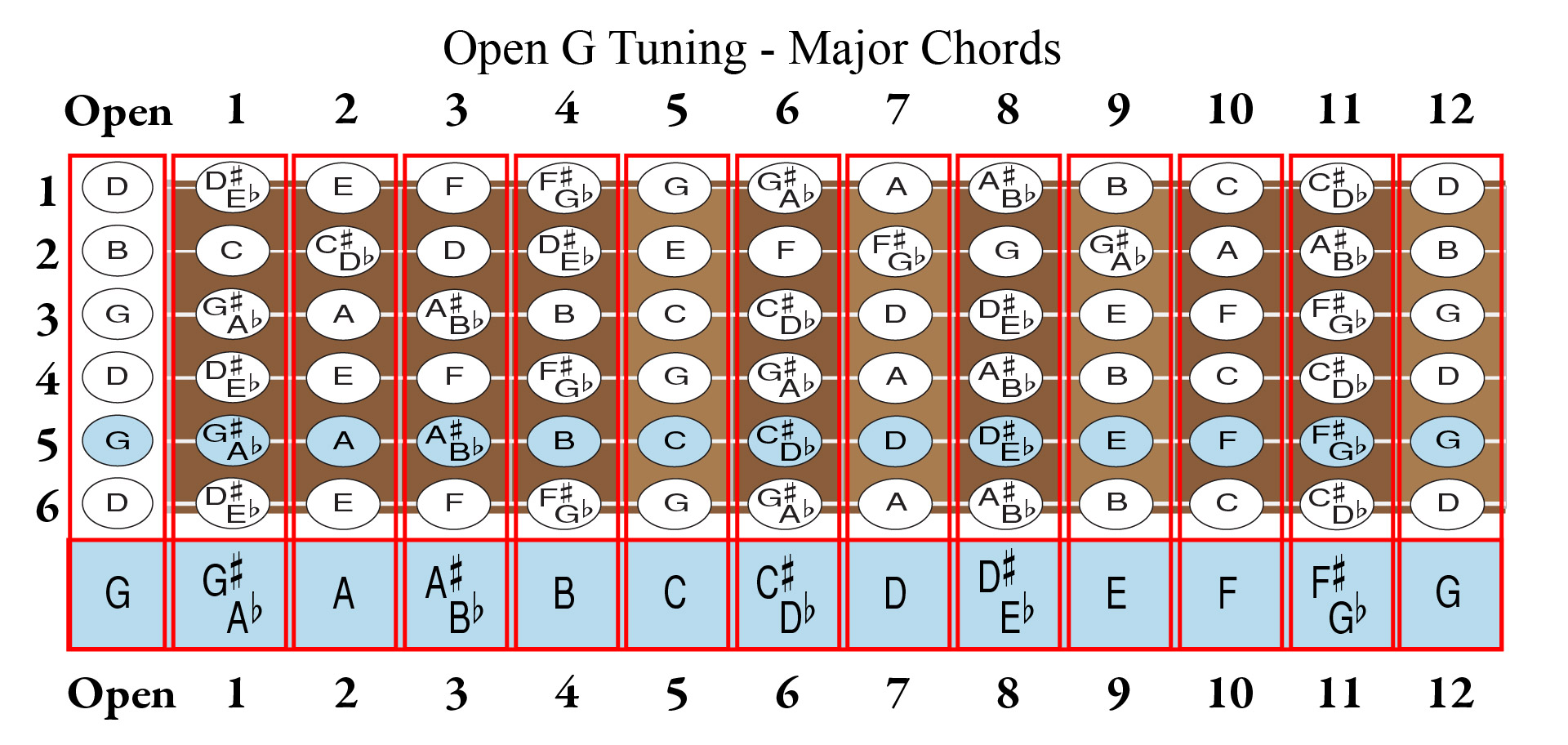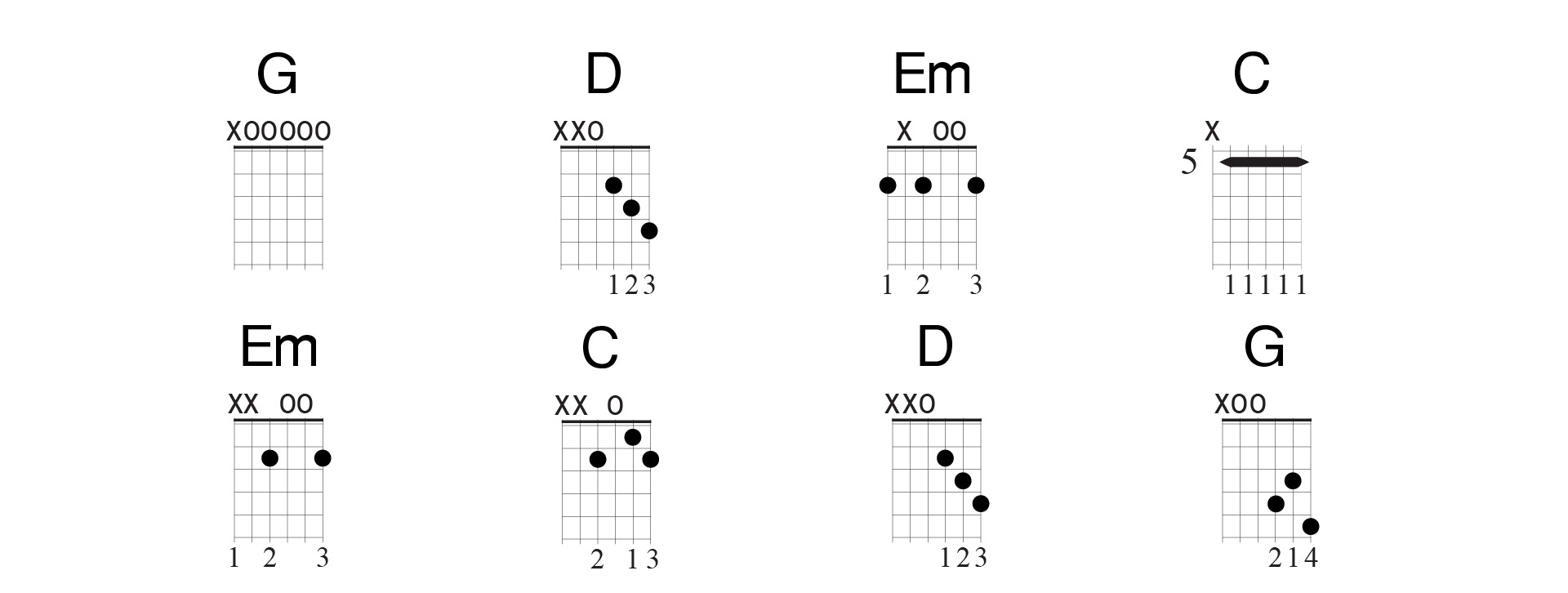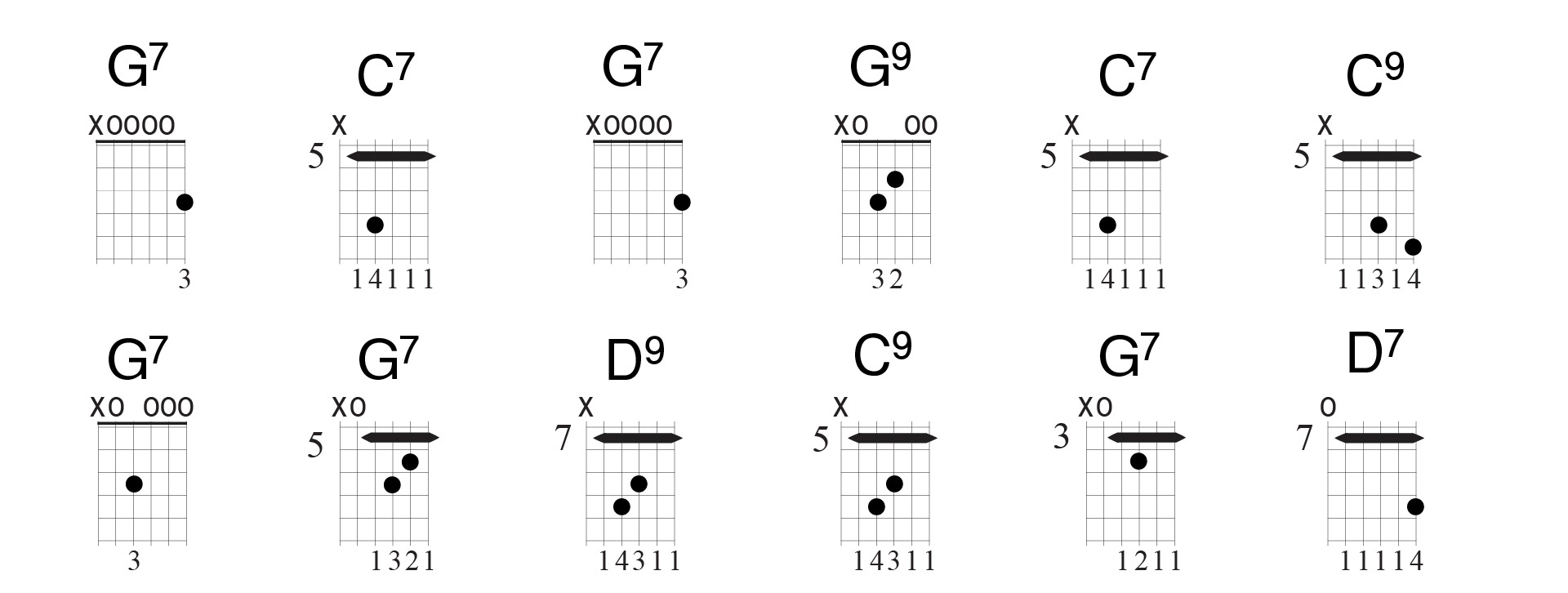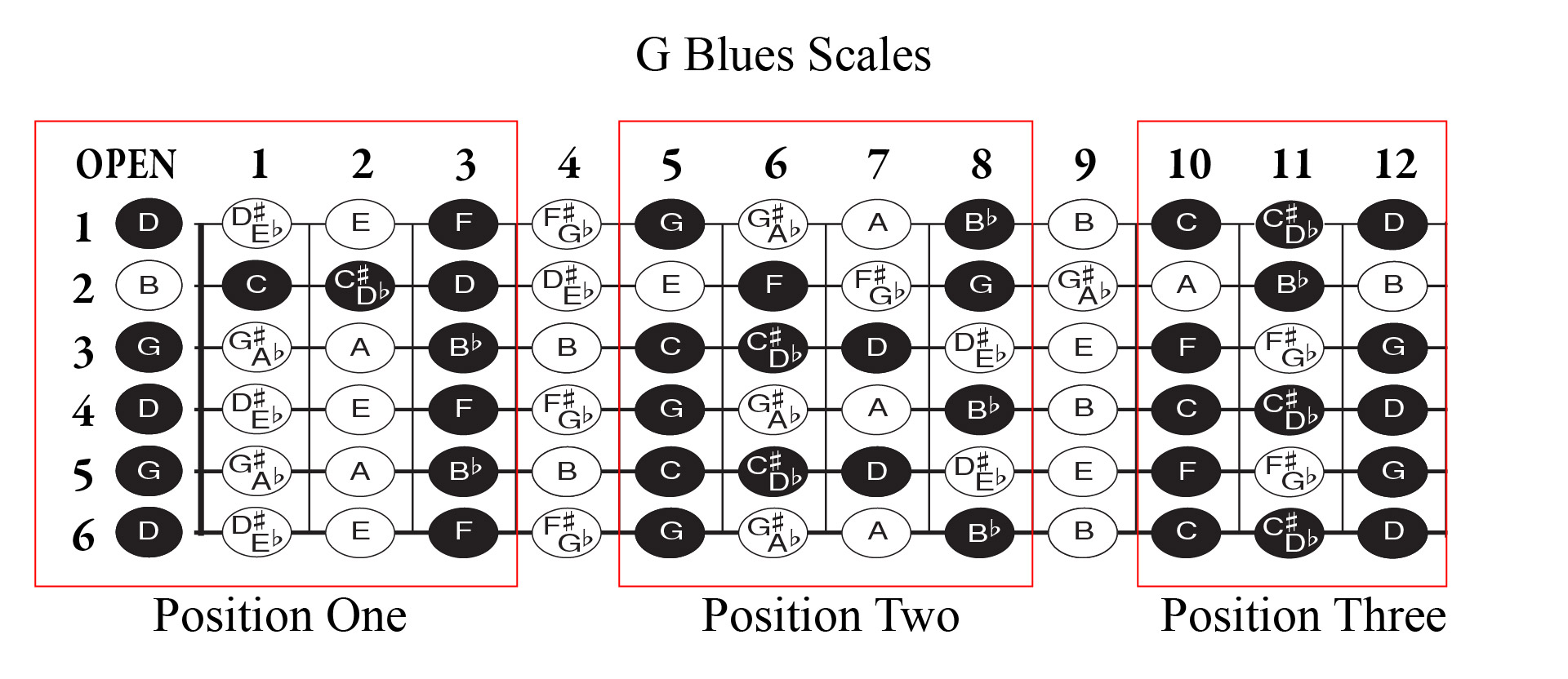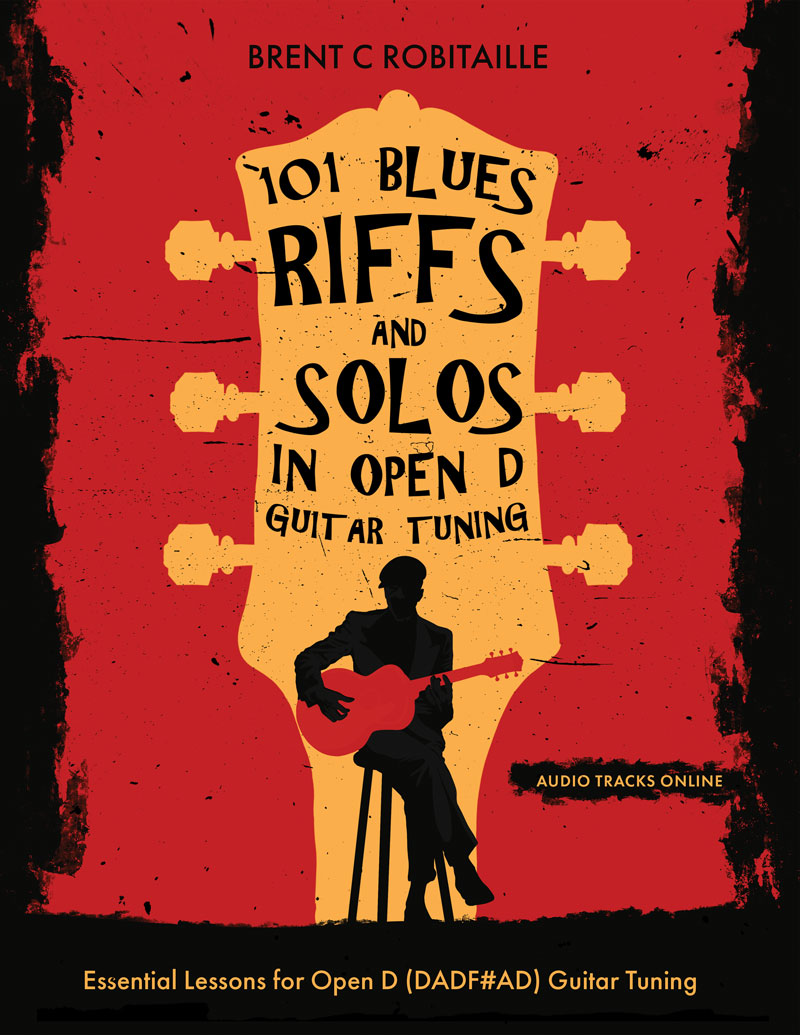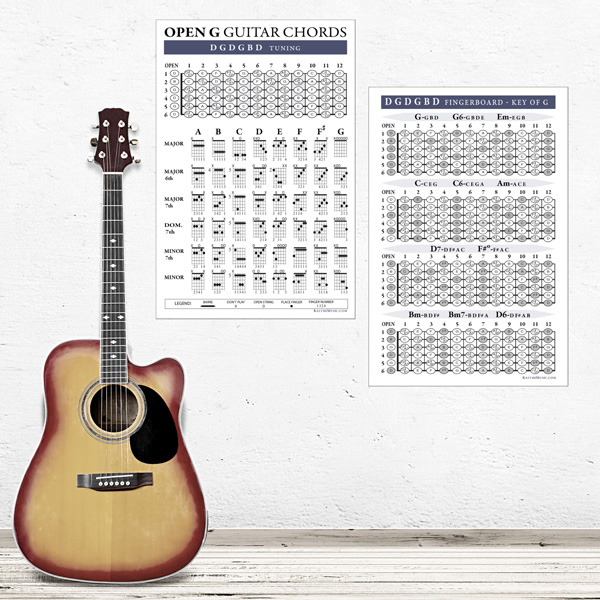Exploring the Versatility and Charm of Open G Guitar Tuning (DGDGBD)
Though standard guitar tuning (E A D G B E) is the most common configuration, many alternate tunings offer unique sonic possibilities and fresh perspectives on playing guitar. One such tuning is Open G (DGDGBD), a popular choice among guitarists seeking a bluesy, resonant, and versatile sound, which is also becoming more mainstream for guitarists of all styles.
As with all tunings, there are benefits and disadvantages; some chords are easy to play, while others pose a real challenge to stretch and reach. One of the apparent advantages when the strings are already tuned to a chord is you can play it with one finger (or with a slide).
In this blog post, we will dive deep into the world of Open G guitar tuning, exploring its history and advantages, learning some chords and scales, playing a few chord progressions and trying an arrangement called “Concession Blues.”
But before you get into playing, here’s a refresher on how to tune to open G.
Want to learn about Open D major chords, go here.
How to Tune to Open G
Most altered guitar tunings you will run across are tuned to a major or minor chord. With open G, we are tuned to a G major chord, which includes the notes G, B and D. There are several versions of Open G tuning, but in this post, we will use the most popular version: 6=D, 5=G, 4=D, 3=G, 2=B,1=D. Here are the strings to tune down from standard guitar tuning:
- Play the open 4th string (D), and lower the 6th string down a whole step. Match the 4th string, so it sounds an octave lower than the 4th
- Now play the 4th string again and lower the 1st string down a whole step from E to D.
- You should have three D’s, one on the 6th, 4th and 1st. Try to get all three D’s in tune together.
- Go on to the 3rd string and tune down the 5th string down a whole step from A to G. This is approximately a 1/3 or 1/2 turn on the tuning peg.
- Leave the 2nd string tuned to B.

Use an electronic tuner, or better yet, try to tune by ear with only a reference note. Tuning by ear takes time, but an excellent skill to master. First, let’s learn where some of the notes are on the fingerboard to get the lay of the land.
Fingerboard Notes in Open G (DGDGBD)
I assume you already understand how notes are arranged in music with sharps and flats and that you are now familiar with the open notes in open G. If you need some basic music theory, check out this post here. In order to memorize the notes, we will start with the open G on the fifth string:

It’s pretty easy to memorize the open notes as three of them are tuned to D (6, 4 and 1), two notes are tuned to G (5 and 3), and one is tuned to B (2). Here are all the fretboard notes up to the twelfth fret:
Are you getting a handle on the fingerboard? Good, we can now tackle our second subject: open G chords. I mean, what is guitar playing without chords? Much of what we do as guitarists is play chords and arpeggios, and there are thousands of open G chords, just like standard tuning. Fortunately, with all open chord tunings, you can play a chord with one finger or use a slide if that’s your mode of attack.
Variations on the Open G Tuning
Variations on Open G:
- Open G: D G D G B D (poster)
- Modal G: D G D G C D
- Open G Minor: D G D G Bb D
- Open G – Lap Steel: G B D G B D
Various forms of Open G are also widely used on other instruments.
Cigar box guitar tuning: 3, 4 and 2-stringed instruments: GDG
Banjo Tunings:
- G Tuning G D G B D,
- G Minor G D G Bb D,
- G Modal G D G C D
Dobro/Resonator/Lap Steel Guitar Tunings:
- Open G: G B D G B D (poster)
- Open G (like Guitar): D G D G B D
- Modal G: D G D G C D
- Open G Minor: D G D G Bb D
Cittern and Bouzouki tunings:
- D G D G D
- G D G D G
- G D A D (Bouzouki)
- G D A E
Open G Guitar Chords
The majority of guitar players begin by learning one specific fingering to play a chord due to the most effortless fingering or best sound, and that is a perfect place to start with Open G chords. Especially when a major chord can be played with one finger or a slide. Remember the notes on the fifth string – use that as a guide to learn all the major chords:
That’s all well and good, but if you want to master the open G tuning, you need to explore other ways to play major chord shapes. Watch the video below to learn 15 ways to play a G major chord in Open G Tuning:
After learning a few chords, memorize the major chord shapes you like and apply them to songs and chord progressions (see below). Make sure to transpose these major chords around the neck so you can access them and play in different keys. Use the fretboard chart above if you need help to move the chords around.
Major Chords are important, but nothing makes a song more poignant than a minor chord…
Love Open D fingerstyle? Have a look at the Classical Guitar Book in Open D Tuning.
Minor Chords in Open G Tuning
What was so easy with a one-finger major chord becomes a challenge when we have to lower a note down a half step to play the minor chord.
The notes in the major chord are 1, 3 and 5, while the minor chord tones are 1, b3 and 5. This limits the ability to play a minor chord with one finger as the notes on the second string are lowered by one fret to form the minor chord.
This poses more of a challenge when playing slide, but a handy workaround exists. Place your finger behind the slide on the second string to override the major chord and play the minor (see this lesson on six tips to play slide guitar). Here is the fretboard showing all the notes in G minor:
Again, find the shapes that you like best and transpose them around the neck. Watch the video showing 15 ways to play a G Minor Chord:
You have played a few chords, and now we will play a few chord progressions that mix and match the major and minor chord shapes.
Chord Progressions with Open G Tuning
Playing the diatonic chords and through some chord progressions will help you memorize the shapes. In this section, we will take some of the most popular chord progressions in popular music and apply them to Open G.
The first chord progression we can try has been used in songs like “Don’t Stop Believing,” and the second chord progression has been used in songs like “Heart of Gold.” Same chords in both with a different order:
Don’t forget about the dominant seventh and ninth chords. This time, we will play a 12-bar blues progression in G:
Have you memorised some of the chord shapes yet? If not, try applying the open G chords to songs in your repertoire. We are not done yet. Next, why not jam a few blues riffs and learn some open G scales?
Can you play a 12-bar blues in Open D guitar tuning? Check out this lesson here.
Want to learn 36 major chords in Open D guitar tuning? Check out the Open D Guitar Chords Major Lesson.
Blues Riffs in Open G Tuning
You can’t have an introduction to Open G guitar tuning without touching on the blues. Many early Open G pioneers were fingerstyle blues players who incorporated the slide and created memorable guitar sonorities.
As you know, tuning to an open string chord is perfect for slide and our fun one-finger approach, but it’s good to think outside the box and just play in open G as you do in your standard guitar tunings. Don’t rely on a few rehearsed riffs – learn the scales and create your own unique improvisations.
These riffs below were primarily crafted using the notes of the G blues scales (G – Bb – C – Db – D – F), and here’s an excellent start to the blues scale in G. Remember, practice the scales in positions like the three below, but also break outside of the box patterns and create solos based on melodic ideas that don’t follow the box patterns.
Easy Blues Riffs in Open G Tuning
And now some blues riffs to jam on in Open G. Listen to the audio below then try the tab underneath:
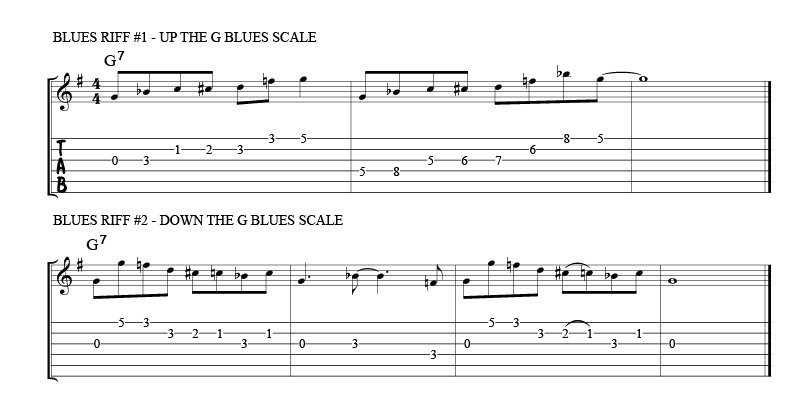
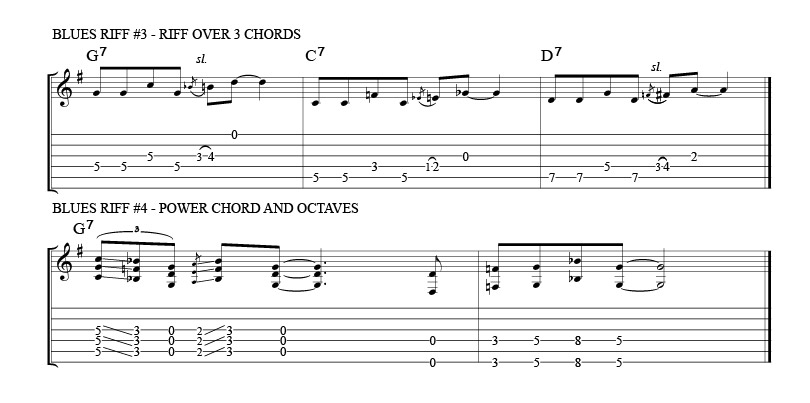

Alright, we are getting there! However, if you look for more guitar music in Open G, you will quickly discover that there still aren’t many suitable arrangements and tabs available.
Due to a lack of popularity or the plain fact that players don’t like to retune or carry around a second guitar, Open G is a bit of a chore at the start.
That aside, take what we can get and learn a fingerstyle blues in open G. One of my own pieces, but hey, it’s worth a try!
Concession Blues Guitar Tab in Open G
The Concession Blues is a fingerstyle piece that can be played with or without a slide. The slide plays the main melodic riff while the thumb keeps a steady bass groove moving along. Make sure to swing the eighth notes and keep the melody notes distinct.
To begin, use the first finger to play the hammer-on and use the slide to go from the 2nd to the 4th fret. Take er’ slow and work it out:
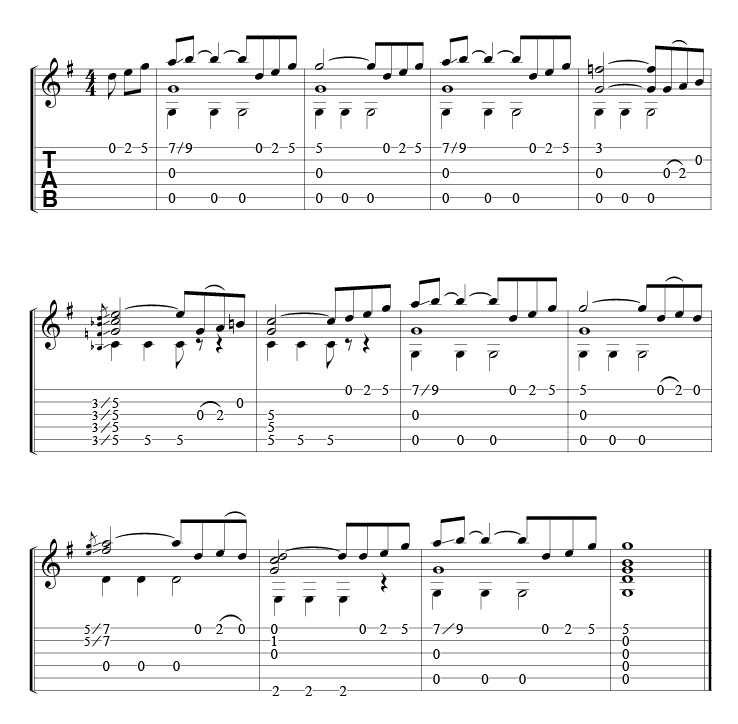
Hopefully, you have developed an interest in your new tuning and want to learn more, but before we sign off, take a gander at where Open G originated from and additional songs to further your studies.
One of the best ways to develop your guitar technique is to flatpick Celtic tunes.
Check out this book: Open G Tuning: Celtic Guitar Flatpicking
History and Influences
The history of Open G tuning is deeply intertwined with the evolution of blues and slide guitar playing. It gained prominence among early Delta blues players who used the tuning to emulate the expressive vocal quality of African-American field hollers and spirituals.
Artists like Robert Johnson and Son House pioneered the use of Open G, paving the way for its adoption in various genres such as rock, country, and folk.
DGDGBD soon became a favourite among blues musicians, particularly slide guitarists, due to its rich, resonant sound.
Eventually, this tuning crept into early rock music with guitarists and bands such as Keith Richards of the Rolling Stones, George Thorogood, Jimmy Page, Joni Mitchell, Dire Straits, Johnny Winter, Pearl Jam and many more.
Summary – Advantages of Open G Tuning
- Resonant and Full Sound
- Slide Guitar Techniques: Accesbile chords and a favourite among many slide guitarists.
- Creative Chord Voicings: Open G tuning encourages guitarists to experiment with new chord shapes and voicings. The open strings can create intriguing and unusual chord progressions that may not be as accessible in standard tuning.
- Adaptation to Multiple Genres: While Open G has deep roots in blues, it has found its way into various genres. From rock legends like Keith Richards of the Rolling Stones to folk singer-songwriters like Joni Mitchell, artists have harnessed its versatility to add depth and character to their music.
- Fingerpicking: The open strings offer some nice drone notes and harmonics possibilities. However, not everything works in Open G, and you will often have to transpose to the Key of D or D.
Let it Ring!
Open G tuning is a testament to the ever-evolving nature of guitar playing. From its bluesy origins to its widespread adoption across genres, this tuning has proven its worth in the hands of countless musicians.
Its resonant sound, compatibility with slide guitar techniques, and creative potential make it a fascinating avenue for beginner and experienced guitarists to explore.
So, whether you’re drawn to the expressive allure of the blues or eager to experiment with novel chord structures, Open G tuning invites you to dive in and unearth a world of musical inspiration.
Check back again for more Open G guitar lessons. Subscribe for new lessons, submit a comment and check out our Open G and D books and sheet music arrangements.
101 Blues Riffs and Solos in Open D Guitar Tuning
Take your Open D guitar playing to the next level with “101 Blues Riffs & Solos in Open D Guitar Tuning.” The most complete instructional book ever written exclusively in DADF#AD tuning. Using a combination of slide, fingerstyle and pick playing, you will cover all the bases needed to develop a solid technique in open D guitar. Everything you need to master the blues with essential lessons in DADF#AD guitar tuning!
• Master the Blues in Open D Guitar Tuning
• Slide, Fingerstyle and Picking Riff and Solos
• Traditional, Delta, Rock, Funk and Jazz Blues
• Extensive Scale, Chord, and Arpeggio Charts
• A Complete Course for Open D (DADF#AD)
• Audio Tracks Below
Open G Tuning Celtic Guitar Flatpicking
Tuning your guitar to “Open G” (DGDGBD) compliments Celtic music brilliantly. The open tuning allows the strings to vibrate, creating drones and overlapped notes that sound reminiscent of a harp or bagpipe.
The tunes represent a good selection of well-known Celtic session tunes, including jigs, reels, hornpipes, waltzes and songs. Each tune shows notation, tablature and chords. Some tunes are arranged in the chord melody style (with pick), while the faster tunes just have the melody line with fingerings and articulations.
OPEN G (DGDGBD) Guitar Chords and Fingerboard Posters
This two-poster guitar chord set is an excellent reference for creative guitarists exploring the world of OPEN G (DGDGBD) altered tunings.


